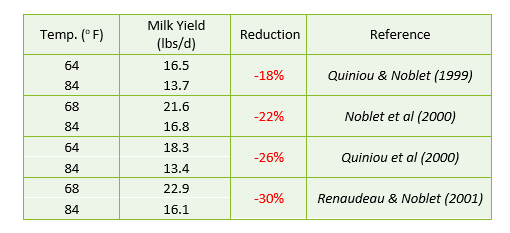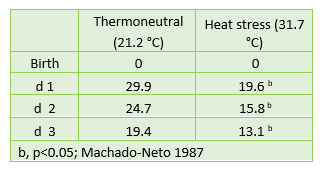

Dr. Joe Loughmiller
j.loughmiller@phileo.lesaffre.com
Senior Swine Technical Services Manager
What is Heat Stress?
Heat stress occurs when a pig is unable to maintain a comfortable body temperature due to high environmental heat and humidity. This becomes especially critical in larger pigs like sows who have a high metabolic rate and limited ability to cool themselves. When this occurs, the internal body temperature rises, and heat producing metabolic functions like digestion, physical activity, feed intake, fertility and milk production are reduced (see table 1).
Table 1. Effects of heat stress on sow milk production.

The problems associated with heat stress are more apparent in modern, fast-growing, high-lean pigs. These animals have higher rates of metabolic activity, increased muscle mass, increased litter size, increased metabolic demand for milk production, and are typically affected more dramatically by the overall environmental stress load. Heat stress has been associated with increased inflammatory immune activity, decreased gut health, reduced follicular development and reduced antibody levels in milk and colostrum. Since antibodies are passively transferred to piglets in colostrum, reduced colostrum antibodies yield lower circulating antibody protection in piglets (see table 2), leading to increased infection risk during these higher stress periods.
Table 2. Decreased piglet serum IgG levels from d 0 to 3 after birth during heat stress.


Using ActiSaf HR+ and SelSaf to help offset the effects of heat stress.
Nutrition, management and environmental accommodation can all help reduce heat stress effects. ActiSaf HR+ and SelSaf are part of these tools that help sows and their offspring better manage the effects of stress, lower feed intake, and immune challenges. By doing so, they help the sow and litter maintain productivity, immune function, health and growth performance.
SelSaf
SelSaf is a dual-action yeast grown in a selenium enriched broth that allows the yeast to naturally substitute Se for S when making sulfur-containing selenoproteins. Dual-action means that it provides selenium through the selenoproteins, selenomethionine and selenocysteine. These selenoproteins acted as both a storage source of Se (selenomethionine) and a readily available source of Se (selenocysteine) (see Figure 1). Thus, it provides a more consistent source of metabolically available Se during times of stress-induced low feed intake with selenomethionine and during more normal production periods with selenocysteine.
Figure 1. SelSaf provides high levels of active Se in circulation and higher storage levels in muscle. Negative control (NC), Sodium Selenite (SS) and SelSaf were measured in pigs fed complete feed containing no (NC) or 0.3 ppm added Se from Sodium selenite or SelSaf selenium yeast.


Phileo by Lesaffre internal data, 2006
ActiSaf HR+
ActiSaf HR+ is a carefully selected Saccharomyces cerevisiae strain of active dry yeast that is pellet stable while also maintaining high viability in mash feeds. It has been selected from over 9,000 strains of yeast in the Lesaffre yeast library. ActiSaf HR+ has demonstrated benefits when fed to sows at rates of 2 to 5 grams/head/day. The feeding rate varies based upon level of stress and specific benefits sought by individual producers. ActiSaf HR+ has many benefits for sows and offspring that become especially valuable during heat stress. Sows fed ActiSaf HR+ have shown improved energy digestibility with a 28% increase in volatile fatty acid (VFA) fermentation yielding more VFAs to be absorbed for metabolic energy needs. ActiSaf HR+ has also shown improvements in sow backfat levels at weaning and litter weaning weight (see Figure 2).
Figure 2. Impact of ActiSaf HR+ on sow backfat levels and litter weaning weight. (Tsika et al., 2015).


In addition to the benefits associated with improvements in sow body condition and litter weight gain, ActiSaf HR+, as a yeast probiotic, is known to stimulate the gut immune system through both the nonspecific pattern recognition receptor pathway and the toll-like receptors that stimulate improved gut epithelial tissue structure. It has also stimulated increased antibody levels in the sows fed ActiSaf HR+ (see Figure 3). This increased antibody production via the dendrite signaling pathway helps increase the antibodies which can protect against diseases that overwhelm the first level of immune defenses and is passed on to the piglets via passive immunity in the colostrum. This becomes even more critical when IgG levels decline during heat stress as observed in Table 1.


Figure 3. Effect of ActiSaf HR+ in sow feed on colostrum and piglet plasma IgG levels at 24 hours after birth (Jang et al., 2013).
The effects of heat stress and other inflammatory stresses are minimized with proper nutrition and management practices. Part of these tools include the use of heat-stable ActiSaf HR+ yeast probiotic to improve gut health, nutrient digestibility, passive immune transfer to piglets, litter growth rates, sow body condition and productivity. An additional tool to help minimize the effects of oxidative stress during heat stress and periods of lower feed intake is the use of SelSaf selenium yeast to provide a dual-action source of selenium yeast to support optimal metabolic activity and higher selenium reserves.




